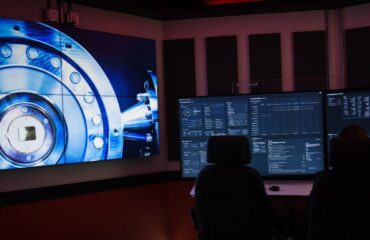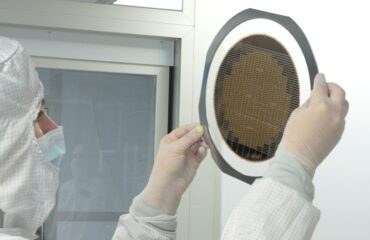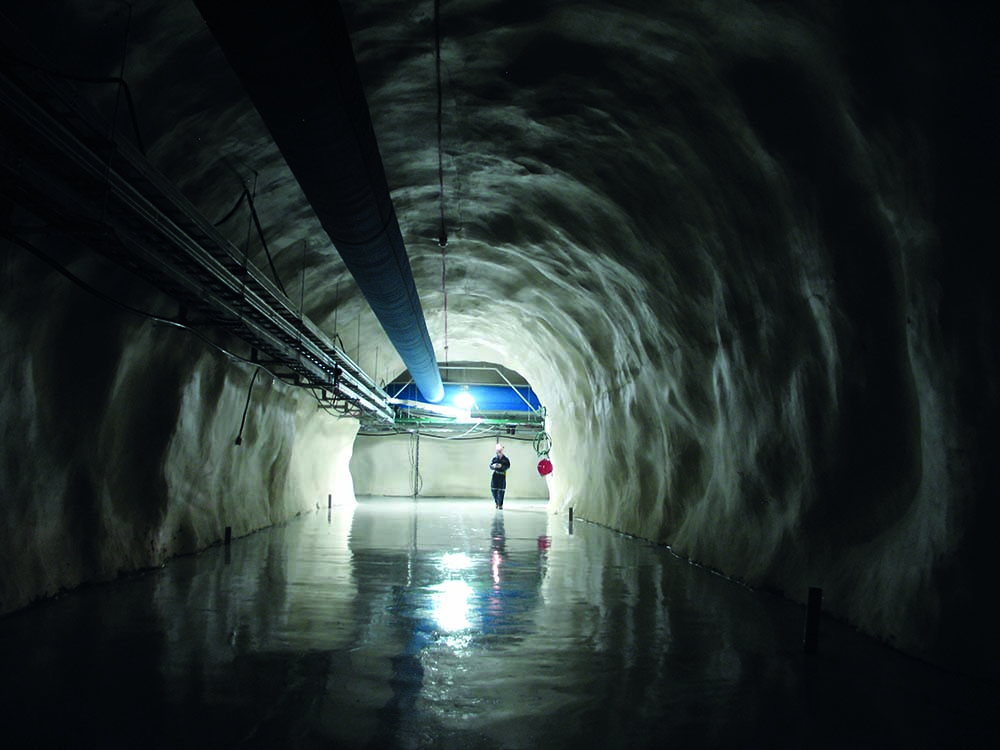
SNOLAB’s deep underground research facility. Image from SNOLAB in CERNCourrier
By Mariana Meneses and James Myers
Researchers from the Institute for Quantum Computing at the University of Waterloo, SNOLAB in Ontario, and Chalmers University in Sweden are collaborating on a groundbreaking project to study how cosmic rays and radiation affect quantum bits (qubits).
Funded by the U.S. Army Research Office, the project will use SNOLAB’s unique two kilometre-deep underground facility to shield experiments from cosmic radiation. The aim is to understand the effects of cosmic rays and reduce errors in quantum information bits (qubits, analogous to the bits in today’s computers) caused by interaction with high-energy particles.
The research could improve quantum computing by addressing the problem of qubit decoherence, where qubits lose the connection of their quantum state due to interference from heat, electromagnetism, and other environmental factors.

Cosmic rays are high-energy particles that interfere with qubits. Image from SNOLAB by ASPERA/Novapix/L. Bret
Located near Sudbury, Canada, SNOLAB (Sudbury Neutrino Observatory Laboratory) is a unique 5,000 square metre research facility built deep underground in Vale’s Creighton mine.
With a staff of over 100 to support the science, the mission of its “cleanroom” in operation since 2011 focuses on neutrino and dark matter studies and other rare physical interactions.
To explore how radiation affects qubits in controlled ways, potentially improving quantum error correction methods, SNOLAB’s CUTE (Cryogenic Underground TEst Facility) Cleanroom will house the quantum experiment.
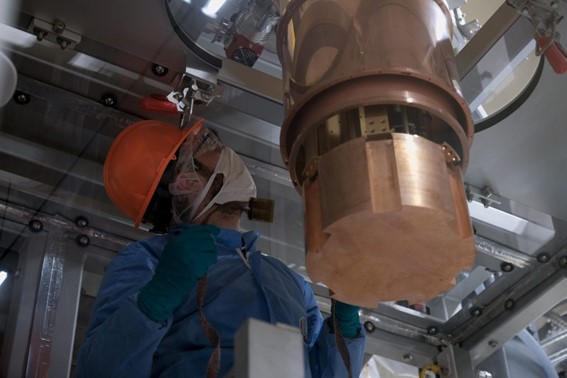
SNOLAB’s CUTE facility uses a combination of lead, water, and polyethelene as shielding from background radiaiton, in addition to SNOLAB’s depth. Image: SNOLAB
SNOLAB was initially designed to study neutrinos, which are elusive subatomic particles emitted by the sun in vast quantities and that appear to interact weakly with matter.
An earlier underground experiment had detected only about one-third the expected number of neutrinos according to the standard model of physics, which physicists called the “Solar Neutrino Problem.” Years of data collected by SNOLAB confirmed that the sun is actually producing neutrinos according to prediction, however in three different varieties or “flavours” which change on their 149 million-kilometre journey to Earth. The previous experiment had counted only one of the flavours.
Director of the Sudbury Neutrino Collaboration Dr. Art McDonald, an astrophysicist, was co-recipient of the 2015 Nobel Prize in Physics “for the discovery of neutrino oscillations, which shows that neutrinos have mass.”
Over time, SNOLAB has expanded its research scope beyond neutrinos to include other fundamental physics and astrophysics investigations.
The quantum bit research collaboration aims to investigate the effect of radiation and cosmic rays on a specific type of qubits called superconducting qubits. These are qubits made from superconducting materials that don’t experience heat resistance because they operate at extremely low temperatures to maintain quantum coherence for longer periods compared to other types of qubits.
Recent experiments have demonstrated the nature of one major problem with qubits when they collide with high-energy particles like cosmic rays or radiation. These energy particles can cause “error hotspots” in the qubits, similar to how a small disruption of a smooth surface like water can create ripples that spread interference. When a qubit is hit by one of these energy particles, it can disturb the qubit and affect the surrounding qubits. This interference can limit how long a quantum computer can effectively perform calculations before errors become too frequent for accurate results.
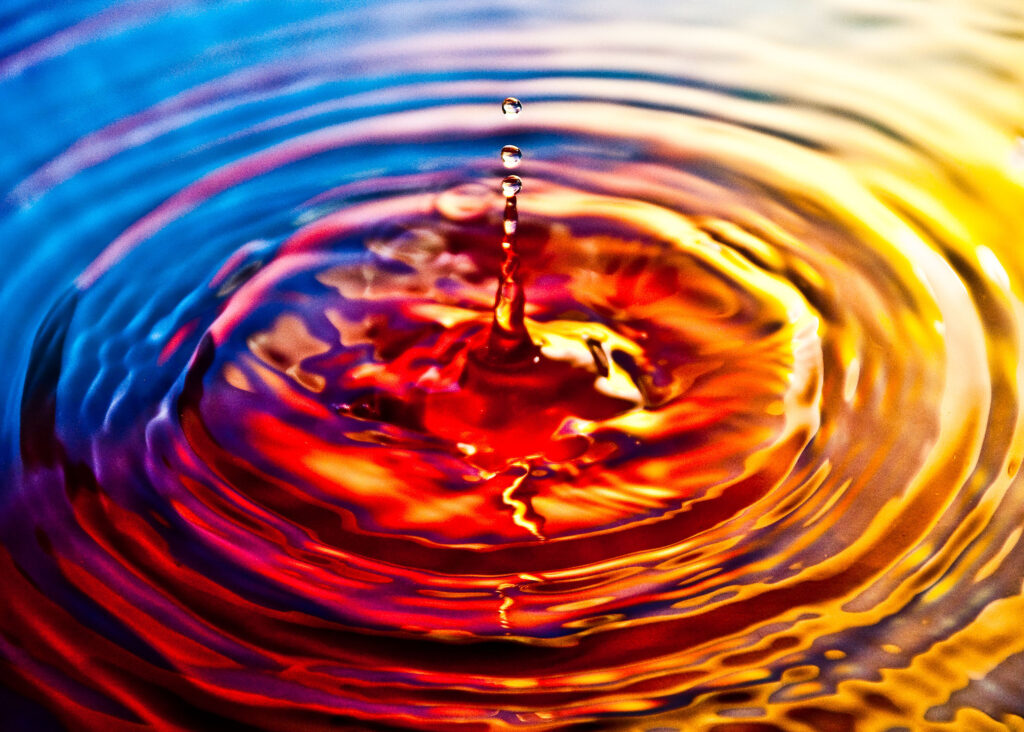
Example of ripple effect on water. Image: Sergiu Bacioiu
Unlike classical computers now in widespread use, which employ well-established error correction methods, superconducting qubits often experience connection errors due to radiation.
This leads to decoherence, when qubits lose their special connection properties due to interference. In our December 2023 article Breakthrough in Error Correction, we reported on the first quantum circuit with “logical qubits” that can perform error correction in a key step towards fault-tolerant quantum computing, from experiments led by Dr. Mikhail Lukin of Harvard University.
The CUTE facility at SNOLAB is designed for testing cryogenic devices in an environment with very low background radiation. It operates at extremely low temperatures (~12 mK) and can hold up to 20kg of weight, making it highly sensitive to small energy deposits from environmental radiation. Originally built for the Super Cryogenic Dark Matter Search experiment (SuperCDMS), CUTE became a user facility at SNOLAB in 2021 and is now available for scientific and technological projects that benefit from its unique conditions.
The new research is sponsored by the U.S. Army Research Office, in a project titled “Advanced Characterization and Mitigation of Qubit Decoherence in a Deep Underground Environment”. The grant was awarded to Dr. Chris Wilson, from the University of Waterloo, Dr. Jeter Hall from SNOLAB and Laurentian University, and Dr. Per Delsing from Chalmers University of Technology.
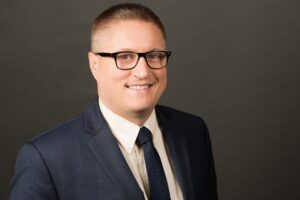
Dr. Jeter Hall, Director of Research at SNOLAB, is a physicist with extensive experience in dark matter detection and quantum technology, and a former postdoctoral researcher known for his work on signal amplification in underground detectors. Image: SNOLAB
“SNOLAB maintains the lowest muon flux in the world and advanced cryogenics testing capabilities, making it an ideal place to conduct valuable research on quantum technologies. In addition, SNOLAB’s next-generation dark matter experiments promise to be early adopters of quantum technology, so we have multiple, vested interests in the outcome of this project,” explained Dr. Hall, referring to muons which are subatomic particles similar to electrons but with much greater mass.
By utilizing SNOLAB’s unique underground environment, the research team aims to systematically study and mitigate the impacts of cosmic radiation on quantum systems.
The findings from these experiments could lead to advancements in quantum error correction techniques, making quantum computers more reliable and efficient. Additionally, understanding how cosmic rays and radiation influence qubits could have broader implications for other technologies and scientific fields. For instance, it could inform the development of more robust quantum sensors and improve our knowledge of fundamental particle interactions.
As quantum technology continues to advance, collaborations like this one are crucial for overcoming existing challenges and unlocking new possibilities.
Craving more information? Check out these recommended TQR articles:
- Race for Post-Quantum Cryptography: Will Proposed Encryption Standards Secure the World’s Data?
- What Will a Recent Quantum Leap in Time Crystal Technology Reveal About the Elusive Nature of Time?
- Breakthrough in Error Correction Opens Potential for Large-Scale Quantum Computer Processing
- The Future of Quantum Computing Accelerates, Many Qubits at a Time
- The Incredible Power of Shape: Fractals Connect Quantum Computers to the Human Body and the Cosmos

